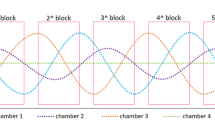Abstract
Investigations have been made on ways to evaluate and visualise the perceived thermal climate. Thermal interaction with windows, heating, ventilation and seating influence the occupant’s thermal situation. When this information on the physical thermal climate is linked together with human thermal sensation in “comfort-zone diagrams”, valuable knowledge about the thermal situation can be visualised. Thermal manikin measurements of local climate disturbances with two different thermal manikins are found to be well correlated with the thermal sensation experienced by panels of subjects exposed to the same conditions. Differences both in manikin shape and construction, as well as testing conditions and panel members, make limit lines differ at some points. Comfort diagrams can be defined by equivalent temperature (t eq) limit lines; however, a consequence of individual and experimental variations is that it is not an optimal solution to have diagrams with absolute limit lines, rather a range of t eq values, forming new “comfort-zone diagrams”. This improvement provides a more appropriate base for assessment of a complex local thermal climate, and opens up the possibility of a general profile that can be used with different manikins, possibly also different methods, in a variety of environments. However, more data from validation experiments with subjects and different methods will contribute to the development of a more general evaluation concept.



Similar content being viewed by others
References
Bedford T (1936) The warmth factor in comfort at work. MRC Industrial Health Board Report, HMSO, London, No. 76
Madsen TL, Olesen B, Reid K (1986) New methods for evaluation of the thermal environment in automotive vehicles. ASHRAE Trans 92:38–34
Nilsson H, Holmér I, Bohm M, Norén O (1997) Equivalent temperature and thermal sensation. Comparison with subjective responses. Recent development and achievements. ATA, Bologna, pp 157–162
Nilsson H, Holmér I, Bohm M, Norén O (1999) Definition and theoretical background of the equivalent temperature (abstract). Int ATA Conf, Florence, 17–19 Nov, abstract no. A4082
Wyon DP (1989) Use of thermal manikins in environmental ergonomics. Scand J Work Environ Health 15 [Suppl] 1:84–94
Author information
Authors and Affiliations
Corresponding author
Rights and permissions
About this article
Cite this article
Nilsson, H.O. Evaluation and visualisation of perceived thermal conditions. Eur J Appl Physiol 92, 714–716 (2004). https://doi.org/10.1007/s00421-004-1111-8
Accepted:
Published:
Issue Date:
DOI: https://doi.org/10.1007/s00421-004-1111-8




